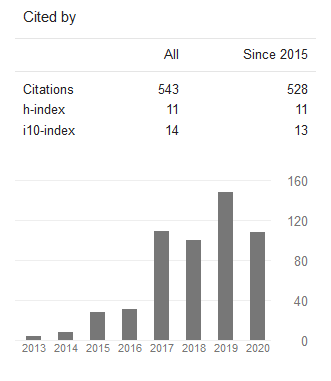Designing User Experience Design of the Healthy Diet Mobile Application Using the Fives Planes Framework
DOI:
https://doi.org/10.24002/jbi.v12i1.4376Abstract
Abstract. Obesity and overweight are becoming increasingly common conditions. On the other hand, the rapid development of technology shows by the increasing number of smartphone users. M-health application can be a solution to the burden of existing health problems. In line with that, the research focused on the quality improvement of user experience in m-Health, especially diet-related apps widely conducted. This study aims to design user experience in a diet-support mobile application called Health-Key using the five planes framework by evaluating usability aspects using the User Acceptance Test. The result of this study is prototype design. Evaluation shows that the designed prototype has good interface, practicality, and efficiency indicator, and 76.9% of respondents stated that the application is feasible, appropriate, useful, and it potentially developed in further iteration with improvements according to the respondents' suggestions.
Keywords: m-health, healthy diet, user experience, five planes framework, user acceptance test.
Abstrak. Designing User Experience Design of The Healthy Diet Mobile Application Using The Fives Planes Framework. Obesitas dan kelebihan berat badan menjadi kondisi gangguan kesehatan yang umum dialami. Di sisi lain, perkembangan teknologi yang kian pesat ditunjukkan dengan semakin banyaknya pengguna smartphone. Aplikasi M-Health (Mobile Health) dapat menjadi solusi dari beban permasalahan kesehatan yang ada. Sejalan dengan itu, penelitian yang berfokus pada peningkatan kualitas pengalaman pengguna M-Health, khususnya aplikasi pendukung diet, banyak dilakukan. Penelitian ini bertujuan untuk merancang desain pengalaman pengguna dalam aplikasi mobile yang mendukung pola diet sehat bernama Health-Key menggunakan The Fine Planes Framework serta mengkombinasikannya denga mengevaluasi aspek kegunaan dengan User Acceptance Test. Hasil dari penelitian ini adalah desain prototipe. Evaluasi menunjukkan bahwa prototipe yang dirancang memiliki indikator antarmuka, kepraktisan, dan efisiensi yang baik, serta 76,9% responden menyatakan bahwa aplikasi layak, tepat-guna, bermanfaat, dan berpotensi dikembangkan dalam iterasi perancangan lebih lanjut dengan perbaikan sesuai saran responden.
Kata Kunci: m-health, healthy diet, user experience, five planes framework, user acceptance test.
References
G. A. Tahir, C. K. Loo, N. Kong, and F. M. Moy, “Evaluation of issues, usability and functionality of dietary related mobile applications: A systematic literature review,” arXiv, pp. 1–34, May 2020.
A. Dutta, A. Puvvala, R. Roy, and P. Seetharaman, “Technology diffusion: Shift happens — The case of iOS and Android handsets,” Technol. Forecast. Soc. Change, vol. 118, pp. 28–43, Feb. 2017, doi: 10.1016/j.techfore.2017.01.024.
J. Chen, J. Lieffers, A. Bauman, R. Hanning, and M. Allman-Farinelli, “Designing health apps to support dietetic professional practice and their patients: Qualitative results from an international survey,” JMIR mHealth uHealth, vol. 5, no. 3, Mar. 2017, doi: 10.2196/mhealth.6945.
A. Skardziute, “mHealth App Developer Economics 2016,” no. October, pp. 1–30, 2016, [Online]. Available: papers3://publication/uuid/BDC0304E-D7E0-4EC1-999B-14B397967A07.
L. Cai, X. He, Y. Dai, and K. Zhu, “Research on B2B2C E-commerce Website Design Based on User Experience,” J. Phys. Conf. Ser., vol. 1087, no. 6, 2018, doi: 10.1088/1742-6596/1087/6/062043.
S. Pan and Z. Wang, “The Exploration of Smart Object Design Method-Applying User Experience Five Elements for Smart Object Design from Theory Research to Design Practice,” J. Phys. Conf. Ser., vol. 1207, no. 1, 2019, doi: 10.1088/1742-6596/1207/1/012007.
A. Syahrina and T. F. Kusumasari, “Designing User Experience and User Interface of a B2B Textile e-Commerce using Five Planes Framework,” Int. J. Innov. Enterp. Syst., vol. 4, no. 01, pp. 44–55, 2020, doi: 10.25124/ijies.v4i01.47.
L. Hardiansyah, K. Iskandar, and H. Harliana, “Perancangan User Experience Website Profil Dengan Metode The Five Planes (Studi kasus: BP3K Kecamatan Mundu),” J. Ilm. Intech Inf. Technol. J. UMUS, vol. 1, no. 01, pp. 11–21, May 2019, doi: 10.46772/intech.v1i01.34.
A. J. Priana, H. Tolle, I. Aknuranda, and E. Arisetijono, “User experience design of stroke patient communications using Mobile Finger (MOFI) Communication Board with user center design approach,” Int. J. Interact. Mob. Technol., vol. 12, no. 2, pp. 162–176, Mar. 2018, doi: 10.3991/ijim.v12i2.7937.
T. Lowdermilk, User-Centered Systems Design. Sebastopol, CA, USA: O'Reilly Media Inc., 2013.
H. M. Hassan and G. H. Galal-Edeen, "From usability to user experience," 2017 International Conference on Intelligent Informatics and Biomedical Sciences (ICIIBMS), 2017, pp. 216-222, doi: 10.1109/ICIIBMS.2017.8279761.
M. Soegaard, The Basics of User Experience Design: A UX Design Book by the Interaction Design Foundation. Copenhagen, Denmark: Interaction Design Foundation, 2018.
D. Dharmayanti, A. M. Bachtiar, and A. P. Wibawa, “Analysis of User Interface and User Experience on Comrades Application,” IOP Conf. Ser. Mater. Sci. Eng., vol. 407, no. 1, 2018, doi: 10.1088/1757-899X/407/1/012127.
D. Benyon, Designing Interactive Systems: a comprehensive guide to HCI and interaction design. Harlow, UK: Pearson Education Limited, 2014.
R. Suman and S. Sahibuddin, “User Acceptance Testing in Mobile Health Applications,” in Proc. 2nd Int. Conf. on Information Science and Systems, pp. 145–149, Mar. 2019, doi: 10.1145/3322645.3322670.
E. V. Sandin, N. M. Yassin, and R. Mohamad, “Comparative Evaluation of Automated Unit Testing Tool for PHP,” Int. J. Softw. Eng. Technol., vol. 3, no. 2, pp. 7–11, Dec. 2016, [Online]. Available: http://ijset.fc.utm.my/ijset/index.php/ijset/article/viewFile/ 60/31.
J. J. Garrett, The Elements of User Experience: User-Centered Design for the Web and Beyond, Second Edition. Berkeley, CA, USA: New Riders, 2011.
S. M. Sadiku, M. N. O., Shadare, A. E., & Musa, “Mobile health,” Int. J. Eng. Res., vol. 6, no. 10, p. 450, Oct. 2017, doi: 10.5958/2319-6890.2017.00061.7.
R. Miao et al., “Factors that influence users’ adoption intention of mobile health: a structural equation modeling approach,” Int. J. Prod. Res., vol. 55, no. 19, pp. 5801–5815, Jun. 2017, doi: 10.1080/00207543.2017.1336681.
C. K. Kao and D. M. Liebovitz, “Consumer Mobile Health Apps: Current State, Barriers, and Future Directions,” PM R, vol. 9, no. 5, pp. S106–S115, May 2017, doi: 10.1016/j.pmrj.2017.02.018.
M. Schrepp, A. Hinderks, and J. Thomaschewski, “Design and Evaluation of a Short Version of the User Experience Questionnaire (UEQ-S),” Int. J. Interact. Multimed. Artif. Intell., vol. 4, no. 6, p. 103, Jan. 2017, doi: 10.9781/ijimai.2017.09.001.
Downloads
Published
Issue
Section
License
Copyright of this journal is assigned to Jurnal Buana Informatika as the journal publisher by the knowledge of author, whilst the moral right of the publication belongs to author. Every printed and electronic publications are open access for educational purposes, research, and library. The editorial board is not responsible for copyright violation to the other than them aims mentioned before. The reproduction of any part of this journal (printed or online) will be allowed only with a written permission from Jurnal Buana Informatika.
This work is licensed under a Creative Commons Attribution-ShareAlike 4.0 International License.










